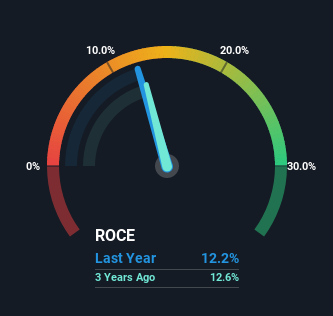Investors Met With Slowing Returns on Capital At SKY Network Television (NZSE:SKT)
If you're not sure where to start when looking for the next multi-bagger, there are a few key trends you should keep an eye out for. Firstly, we'll want to see a proven return on capital employed (ROCE) that is increasing, and secondly, an expanding base of capital employed. Basically this means that a company has profitable initiatives that it can continue to reinvest in, which is a trait of a compounding machine. However, after investigating SKY Network Television (NZSE:SKT), we don't think it's current trends fit the mold of a multi-bagger.
Return On Capital Employed (ROCE): What is it?
For those that aren't sure what ROCE is, it measures the amount of pre-tax profits a company can generate from the capital employed in its business. To calculate this metric for SKY Network Television, this is the formula:
Return on Capital Employed = Earnings Before Interest and Tax (EBIT) ÷ (Total Assets - Current Liabilities)
0.12 = NZ$59m ÷ (NZ$693m - NZ$207m) (Based on the trailing twelve months to December 2021).
Therefore, SKY Network Television has an ROCE of 12%. That's a pretty standard return and it's in line with the industry average of 12%.
Check out our latest analysis for SKY Network Television
In the above chart we have measured SKY Network Television's prior ROCE against its prior performance, but the future is arguably more important. If you'd like, you can check out the forecasts from the analysts covering SKY Network Television here for free.
What Does the ROCE Trend For SKY Network Television Tell Us?
We've noticed that although returns on capital are flat over the last five years, the amount of capital employed in the business has fallen 72% in that same period. When a company effectively decreases its assets base, it's not usually a sign to be optimistic on that company. So if this trend continues, don't be surprised if the business is smaller in a few years time.
Another point to note, we noticed the company has increased current liabilities over the last five years. This is intriguing because if current liabilities hadn't increased to 30% of total assets, this reported ROCE would probably be less than12% because total capital employed would be higher.The 12% ROCE could be even lower if current liabilities weren't 30% of total assets, because the the formula would show a larger base of total capital employed. With that in mind, just be wary if this ratio increases in the future, because if it gets particularly high, this brings with it some new elements of risk.
The Key Takeaway
Overall, we're not ecstatic to see SKY Network Television reducing the amount of capital it employs in the business. It seems that investors have little hope of these trends getting any better and that may have partly contributed to the stock collapsing 71% in the last five years. Therefore based on the analysis done in this article, we don't think SKY Network Television has the makings of a multi-bagger.
If you're still interested in SKY Network Television it's worth checking out our FREE intrinsic value approximation to see if it's trading at an attractive price in other respects.
While SKY Network Television isn't earning the highest return, check out this free list of companies that are earning high returns on equity with solid balance sheets.
Have feedback on this article? Concerned about the content? Get in touch with us directly. Alternatively, email editorial-team (at) simplywallst.com.
This article by Simply Wall St is general in nature. We provide commentary based on historical data and analyst forecasts only using an unbiased methodology and our articles are not intended to be financial advice. It does not constitute a recommendation to buy or sell any stock, and does not take account of your objectives, or your financial situation. We aim to bring you long-term focused analysis driven by fundamental data. Note that our analysis may not factor in the latest price-sensitive company announcements or qualitative material. Simply Wall St has no position in any stocks mentioned.


